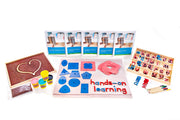The holiday shopping season is well upon us. This is the perfect time of year to start thinking about teaching kids about money. We can begin to teach our practical money skills such as responsible spending, budgeting, buying choices, and money management. These are great skills not only for holiday spending but all year long. By laying a foundation for wise money management now, we set our kids up for life.
Tips for Teaching Kids About Money
- Switch to cash- It is a much more hands-on way for kids to *get* money. They can help you count out money at the store, grab the exact amount of cash budgeted, count change, etc. Plus study after study has shown that we spend less when we use cash so it’ll help you save money too!
- Teach value early- With ShillerLearning’s materials, even young children begin to grasp the concept of money. We make it hands-on, fun, and easy to teach. Children will have fun playing store and you’ll be pleased they’re learning about money!
- Set a budget- Working on the budget as a family is an incredible way to teach children about money. While you may not want to disclose all the details about your finances with them, budget what you can. They could take part in setting the grocery budget or budget for your next vacation.
- Let them take the reins- I have a friend who gives her kids a $50 budget for their 9th birthday party. The children are responsible for figuring out what they want to do for their birthday. Mom and Dad are there to help with pricing research as needed. But the kid handles making all the final decisions, purchases, and sticking to a budget. Every year they get a larger birthday party budget and more responsibilities. If they don’t want to have a party, they can choose to keep the money. My friend has had kids take the family out to dinner, shop thrift stores for a costume party, and hire balloon guys! These kids have thrown AWESOME parties. The kids have an incredible sense of pride and get awesome practical money skills too!
- Help them with their BHAG- Have you heard of the Big Hairy Audacious Goal or BHAG? Do you have a tiny entrepreneur who wants to start a business? Help them reach their dreams. Even if they only pull in a few bucks a year, the financial benefits they’ll gain will be incredible.
- Teach through play- Play is the #1 teaching tool for young kids. Teaching kids about money through play will help lessons stick for life. Children LOVE to play with money. Give them plenty of opportunities to play store, bank, budget setting, and “grown up” money use.
- Allow them freedom with their money, with limits- When your children earn money allow them to decide what they want to do with it. Make sure to set solid limits. Some families say kids need to divide their money up into different categories (Save, Share, Spend, College, Activities are common categories). Other parents say kids can spend their money on whatever they’d like without running it by mom and dad first. While some parents want a parental pass at the spending first. Set clear limits for your family values and let kids make independent choices within those values.
- Put teens through a financial management program- There are some fantastic programs out there! If teens head off to college with solid financial knowledge, they won’t have to live the “poor college kid life.”
- Teach the value of work- Try offering extra jobs around the house or give the kids a chance to help neighbors or relatives. These should be tasks beyond their daily chores. Tasks that you don’t require them to do but they may choose to do for money. If they want extra money, great, they can do the job!
- Have open communication- Explain to your children how you make big money decisions. Share with them about what the process is like. Let them hear some of your internal dialogue and decision-making process out loud. This helps build a better understanding of how to decide what to spend on. When going through the ShillerLearning Language Arts lessons on principled thinking, include money topics in the discussion.
- Include current events- Share money-related news articles, videos, and TED Talks as a springboard for conversation.
- Ask them questions- The best way to check in with what our kids know is to ask. Sometimes the best-laid plans don’t work out. Check in with your kids from time to time. Ask them questions about money, see what they are learning and understanding. That way you’ll know if they’re misunderstanding or not quite getting the values you’re teaching.
What are your tips for teaching kids about money?
Like this? Check out our math kits to help teach your children more about money. They help children understand the concept of money, make change, and other practical money skills.






